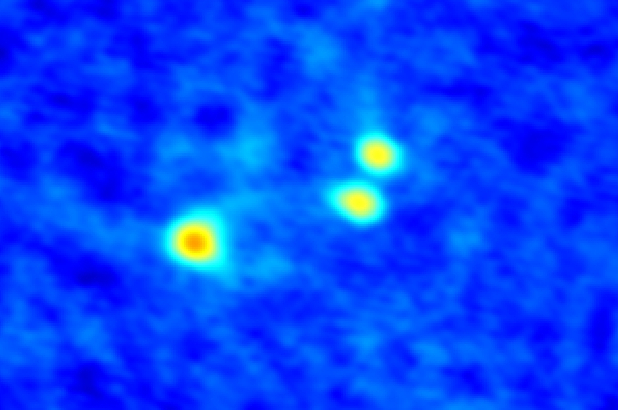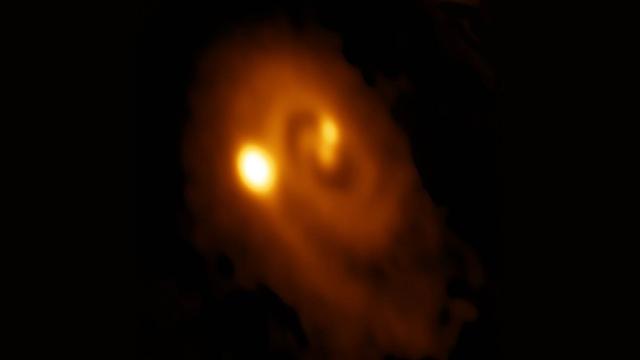Using the ALMA telescope, astronomers have captured an exceptionally clear image of a triple protostar system still in the early stages of development. The new image is providing fresh insights into multi-star systems and how they come into existence.
Our best view yet of a triple star system in the midst of forming. The bright object at left is the newest member of the group. (Image: B. Saxton: NRAO/AUI/NSF; ALMA (ESO/NAOJ/NRAO))
This baby protostar system is called L1448 IRS3B, and it’s less than 150,000 years old — a minor blip in cosmological terms. It features a spiral protostellar disk and three young stars embedded within it. Astronomers are familiar with L1448 IRS3B, but this is easily the best image ever captured of a nascent triple star system. Thanks to ALMA, it features twice the resolution and nearly 10 times the sensitivity of previous observations.
What’s particularly fascinating about this image is the position of the baby stars relative to one another. As a new study published in Nature points out, it’s changing our conceptions of how multi-star systems emerge from the swirling mass of gas and dust within a protostellar disk. This image suggests there are at least two ways in which multi-star systems can emerge, and that in this case, a third star popped into existence around stars that had already formed. Previous observations show these stars can also form independently from one another in their own clouds of gas and dust.

An 8mm wavelength image captured by the Very Large Array telescope offers a different view of the system. (Image: John Tobin from data obtained with the VLA telescope)
L1448 IRS3B spans about 800 astronomical units (AU), which is about eight times the diameter of our solar system. The two protostars at the centre of the disk are about 61 AU apart, while the third member resides at a distance of about 183 AU from the core (for reference, Pluto is about 40 AU from Earth). This outlying, bright feature is assumed to be the most recently formed member of the group. In the new study, a team led by University of Oklahoma astronomer John Tobin says this orientation suggests the system recently experienced a period of gravitational turmoil, resulting in the birth of at least one of the three stars.
Our sun has no stellar companion, but around half of all sun-like stars in the galaxy reside in a multi-star system. In terms of how these systems form, it’s thought that gravitational perturbations within the protoplanetary disk causes the dense material within it to fragment. Over time, these instabilities continue to swirl and gather material around them, eventually combusting into a fully-fledged star. But as this new image attests, there are two ways in which this can happen: Either through large-scale fragmentation or small-scale fragmentation. L1448 IRS3B is an example of the latter.
“Large-scale fragmentation refers to multiple stars that form more or less independently from each other with thousands of AU separation,” Tobin explained to Gizmodo. He says this happens in independent dense clouds that form from turbulence within the molecular clouds. “Small-disk fragmentation happens on a few hundreds of AU scales in a disk of material that is orbiting around a young star that has already formed.”
Protostellar disks are similar to protoplanetary disks that are typically found around more-evolved young stars. But in order to fragment, the disk has to have a large enough mass relative to the mass of the star (or stars) it is orbiting around. “Protoplanetary disks are typically too low in mass to have the potential to fragment, but early-on, while the star is forming and the disk and star are being built up, the disks can be more massive and susceptible to fragmentation,” said Tobin.
And indeed, calculations performed by Tobin’s team showed that this protostellar disk should become unstable at radii of between 150 and 320 AU — a range that fits nicely with the distance between the two protostars at the center of this system, and the third member of the spiral arm.
Looking ahead, Tobin’s team is planning to conduct a more detailed and higher resolution investigation of the system using ALMA, which should help them to better understand its spiral structure and the way it rotates. They’re also going to look at the different molecules that might be present within the disk.
[Nature]
